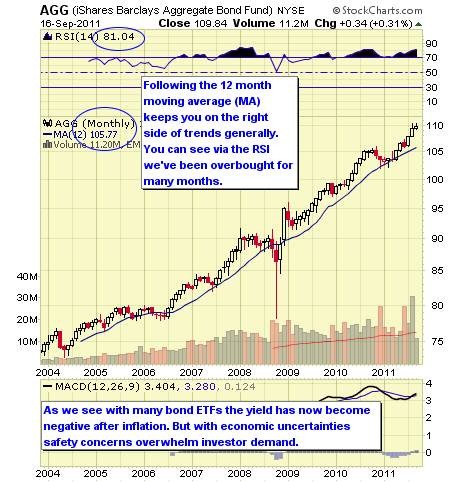Beyond The 10 Year Treasury Yield How To Follow The Bond Market With ETFs
Post on: 21 Май, 2015 No Comment

A trader works on the floor of the New York Stock Exchange on August 18, 2011 in New York. The Dow Jones Industrial average ended up closing down approximately 420 points. The Dow Jones Industrial Average closed down 419.63 points (3.68 percent) to 10,990.58, following an earlier rout on Europe’s bourses. The broader S&P 500 sank 53.23 points (4.46 percent) to 1,140.65, while the tech-heavy Nasdaq Composite was hit harder by selling, tumbling 131.05 (5.22 percent) to 2,380.43. The spark to the new fall was a Morgan Stanley report warning that global growth was slowing and that the United States and Europe were on the precipice of plunging into a new recession, two years after the end of the last one. (Image credit: AFP/Getty Images via @daylife)
The 10 year Treasury rate is often the only piece of market data reported by the media about the bond market. Just like the Dow Jones Industrial Average is an extremely flawed measure of stock market performance, the 10 Year Treasury often misrepresents the performance of the bond market. In fact, the value of the 10 Year Treasury could rise in value while the value of the your “core bond fund” could fall.
Why is the yield on the 10 year Treasury misleading?
The shape of the yield curve matters, not just one point of data. Yields for all bond maturities don’t move together. You could have a situation where yields on short maturity bonds increase and longer dated maturities decrease in yield. (This is called the flattening of the yield curve. Click here for more information the yield curve).
The 10 year Treasury is more sensitive to changes in interest rates than the bond funds in your portfolio.
The 10 year Treasury has a maturity of 10 years and duration of 9.1 years. Duration is a measure of interest rate risk, which you can learn more about here. The largest bond mutual fund in the world, The PIMCO Total Return Fund. has an average maturity of 5.9 years and a duration of 4 years. The largest bond ETF in the world, BND, has an average maturity of 7.1 years and and a duration of 5.2 years. What happens to the 10 year treasury rate is less important to investors in the largest bond mutual fund and ETF than what happens to interest rates in the 5 to 7 year maturity range.
The 10 year Treasury provides no information on credit risk.
If you invest in corporate bonds. your returns have to do with changes in the yields on Treasuries and the premium (additional yield) that investors demand to hold bonds which are riskier than treasuries. This is also known as the credit spread, which you can learn more about here. Credit spreads can often compress and widen. Changes in the credit spread, particularly for high yield bonds, can overwhelm the impact of changes in treasury yields.
What should you follow instead of the 10 Year Treasury Yield?
If you want to follow just one ETF, I would follow the Vanguard Total Bond Market Fund (BND ).
While this ETF will not provide information on the shape of the yield curve, its average maturity and duration should be much closer to the bonds / bond funds in your portfolio. Also, while the majority of BND is invested in US government guaranteed bonds, it does contain a sizable amount of investment grade corporate debt. This means gains and losses in BND do contain some information about changes in the credit risk premium.
If you want to follow changes in the shape of the yield curve, I would follow the following ETFs from iShares: SHY, IEF, and TLT which hold US government bonds of different maturities.














